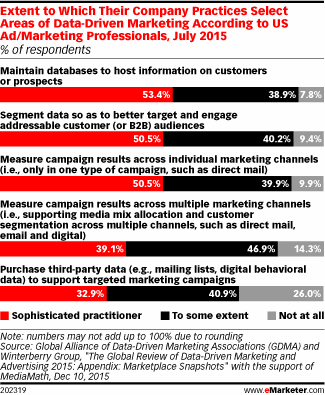Data driven marketing is leading us towards more integrated marketing strategies, where data from different sources are combined to see the bigger picture. The key to success is to tap into relevant data from a range of campaigns. It’s possible to achieve highly optimized campaigns, and deliver content that is more targeted and personal.
In order to reach the right audience, you need accurate consumer insights, and you need to embed these into the planning stages. By using the right data at the right time, you can respond faster to consumer behavior and reach your audience.
Data driven marketing is a new tactic for marketers, where data actually underpins decisions. In order to leverage data for marketing, you need four key pieces of information:
Big Data promises incredible insights into consumer trends, and new ways to look at consumers’ journeys as they interact with a brand in different ways. But businesses need to prepare—and crucially, they need to filter. 91 per cent of marketers have segmentation strategies already, and this is where personalized content can come into its own.
If you want to win market share in 2016, you’re going to need to blend creativity with technology, and data is the secret ingredient that binds them. But before we look at that, we need to look at what data actually is.
Not all data is equal; it’s possible to have too much data to work from. If you try to incorporate every scrap of data, you’re going to lack clear direction in your strategy. Additionally, you need to focus on data quality, because incorrect or incomplete records will hurt your ROI.
Changing habits is never easy, but there are two areas where you’re going to renew your focus:
You know you need accurate data, and an effective strategy to use it. But what are your data sources— are there any you can leverage, that you aren’t currently using?
Typically, marketers need to tap into business software, and form integrations that offer a single customer view. This means pulling in clean data from CRM, ERP and customer service systems, as well as social media, web analytics and automation software.
You can also leverage consumer feedback and face-to-face interaction, such as marketing initiatives at trade shows and meetings. Wearable devices and the Internet of Things are also bringing in new opportunities to see how consumers behave, while generating constant, real-time streams of data.
Take care not to use data irresponsibly. According to the Aimia Institute, people are sensitive about the data they provide, and may actually avoid giving businesses their personal data. A poorly targeted campaign can be to blame. Consider these statistics:
It’s critical to be smart with campaigns so that you aren’t cut out of the conversation.
According to Gartner, the right data is the magic ingredient that helps you to identify customer preferences and
uncover unmet needs. In order to do this, you need to measure the things that matter, and discard the bad data that will weigh you down.
The Direct Marketing Association found that revenues generated by data-driven marketing grew for 46 per cent of US marketers from Q1 to Q2 in 2015. 53 per cent of respondents said that they expected revenue to increase in the third quarter.
Marketers are learning new ways of leveraging the data they hold. If they don’t have clean data driving automation and strategy, they could fail to deliver the personalized content their audiences demand. Marketing analytics suites help businesses deploy a range of data driven strategies for effective personalized approaches. Position² provides your business with a fully integrated suite of digital marketing solutions—including marketing analytics—that help convert leads into customers.